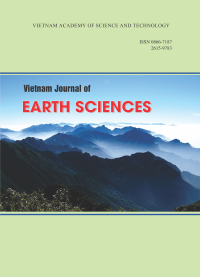Soil Salinity Prediction Using Satellite-Based Variables and Machine Learning: Case study in Tra Vinh province, Mekong Delta, Vietnam
Author affiliations
DOI:
https://doi.org/10.15625/2615-9783/22438Keywords:
Soil salinity, Tra Vinh province, Mekong delta, machine learningAbstract
The precision of estimating soil salinity is considered a key task in solving soil salinity problems and irrigation management of agriculture. This problem is increasingly important in the Mekong Delta, where it is severely affected by this phenomenon in the context of climate variability. Therefore, this paper aims to construct a soil salinity map with high accuracy using machine learning and Sentinel 2A, namely Xgboost (XGB) and Random Forest (RF). The province of Tra Vinh in the Mekong Delta has been selected as the case study. 68 soil salinity samples were collected in August 2024, and 25 conditioning factors extracted from the Sentinel 2A image were used as input data for the machine-learning model. Three statistical indices, namely root mean square error (RMSE), mean absolute error (MAE), and coefficient of determination (R2), were used to evaluate the effectiveness of machine learning models. The results showed that with an R2 value of 0.86, the XGB model was superior to the RF model with an R2 value of 0.67.
Furthermore, Tra Vinh province, the coastal region, and along the Mekong River are more severely affected by soil salinity with an electrical conductivity (EC) value of more than 10. This region, more affected by soil salinity, is related to rising tides and sea levels in the context of climate variability. This study plays an important role and can support farmers in regions affected by soil salinity in building investment measures to reduce the impacts of soil salinity on the development of agriculture.
Downloads
References
Aksoy S., et al., 2024. Assessment of soil salinity using explainable machine learning methods and Landsat 8 images. International Journal of Applied Earth Observation and Geoinformation, 130, 103879.
Breiman L., 2001. Random forests. Machine learning, 45, 5–32.
Chaaou A., et al., 2024. Potential of land degradation index for soil salinity mapping in irrigated agricultural land in a semi-arid region using Landsat-OLI and Sentinel-MSI data. Environmental Monitoring and Assessment, 196(9), 843.
Cramer V.A., et al., 2004. The influence of local elevation on soil properties and tree health in remnant eucalypt woodlands affected by secondary salinity. Plant and Soil, 265(1), 175–188.
Dunlop G., et al., 2019. Simulation of saltwater intrusion into coastal aquifer of Nagapattinam in the lower cauvery basin using SEAWAT. Groundwater for Sustainable Development, 8, 294–301.
Erkin N., et al., 2019. Method for predicting soil salinity concentrations in croplands based on machine learning and remote sensing techniques. Journal of Applied Remote Sensing, 13(3), 034520–034520.
Eswar D., et al., 2021. Drivers of soil salinity and their correlation with climate change. Current Opinion in Environmental Sustainability, 50, 310–318.
Fathizad H., et al., 2020. Investigation of the spatial and temporal variation of soil salinity using random forests in the central desert of Iran. Geoderma, 365, 114233.
Friedman J.H., 2001. Greedy function approximation: a gradient boosting machine. Annals of Statistics, 1189–1232.
Garajeh M.K., et al., 2021. An automated deep learning convolutional neural network algorithm applied for soil salinity distribution mapping in Lake Urmia, Iran. Science of the Total Environment, 778, 146253.
Ge X., et al., 2022. Updated soil salinity with fine spatial resolution and high accuracy: The synergy of Sentinel-2 MSI, environmental covariates and hybrid machine learning approaches. Catena, 212, 106054.
Gerardo R., I.P. de Lima, 2022. Sentinel-2 Satellite Imagery-Based Assessment of Soil Salinity in Irrigated Rice Fields in Portugal. Agriculture, 12(9), 1490.
Gorji T., et al., 2017. Monitoring soil salinity via remote sensing technology under data scarce conditions: A case study from Turkey. Ecological Indicators, 74, 384–391.
Habibi A., et al., 2023. Flood susceptibility mapping and assessment using regularized random forest and naïve bayes algorithms. ISPRS annals of the photogrammetry. Remote Sensing and Spatial Information Sciences, 10, 241–248.
Isidoro D., S. Grattan, 2011. Predicting soil salinity in response to different irrigation practices, soil types and rainfall scenarios. Irrigation Science, 29, 197–211.
Islam A.R.M.T., et al., 2021. Flood susceptibility modelling using advanced ensemble machine learning models. Geoscience Frontiers, 12(3), 101075.
Jiang H., et al., 2019. Quantitative assessment of soil salinity using multi-source remote sensing data based on the support vector machine and artificial neural network. International Journal of Remote Sensing, 40(1), 284–306.
Kaplan G., et al., 2023. Soil salinity prediction using Machine Learning and Sentinel-2 Remote Sensing Data in Hyper-Arid areas. Physics and Chemistry of the Earth, Parts a/b/c, 130, 103400.
Keilholz P., et al., 2015. Effects of land use and climate change on groundwater and ecosystems at the middle reaches of the Tarim River using the MIKE SHE integrated hydrological model. Water, 7(6), 3040–3056.
Khanh P.T., et al., 2024. Evaluation of machine learning models for mapping soil salinity in Ben Tre province, Vietnam. Multimedia Tools and Applications, 1–20.
Kim-Anh N., et al., 2020. Soil salinity assessment by using near-infrared channel and Vegetation Soil Salinity Index derived from Landsat 8 OLI data: a case study in the Tra Vinh Province, Mekong Delta, Vietnam. Progress in Earth and Planetary Science, 7(1), 1–16.
Kiriakidou N., et al., 2024. C-XGBoost: A tree boosting model for causal effect estimation. IFIP International Conference on Artificial Intelligence Applications and Innovations, Springer, 58–70. Doi://doi.org/10.1007/978-3-031-63219-85.
Langsetmo L., et al., 2023. Advantages and disadvantages of random forest models for prediction of hip fracture risk versus mortality risk in the oldest old. Journal of Bone and Mineral Research Plus, 7(8), e10757.
Lee S., et al., 2017. Spatial prediction of flood susceptibility using random-forest and boosted-tree models in Seoul metropolitan city, Korea. Geomatics, Natural Hazards and Risk, 8(2), 1185–1203.
Loc H.H., et al., 2021. How the saline water intrusion has reshaped the agricultural landscape of the Vietnamese Mekong Delta, a review. Science of the Total Environment, 794, 148651.
Mantena S., et al., 2023. Prediction of soil salinity in the Upputeru river estuary catchment, India, using machine learning techniques. Environmental Monitoring and Asessment, 195(8), 1006.
Mehla M.K., et al., 2024. Soil salinity assessment and mapping using spectral indices and geostatistical techniques-concepts and reviews. Remote Sensing of Soils, Elsevier, 429–437.
Metternicht G.I., J. Zinck, 2003. Remote sensing of soil salinity: potentials and constraints. Remote Sensing of Environment, 85(1), 1–20.
Mirlas V., 2012. Assessing soil salinity hazard in cultivated areas using MODFLOW model and GIS tools: a case study from the Jezre'el Valley, Israel. Agricultural Water Management, 109, 144–154.
Ngoc T.A., 2017. Assessing the effects of upstream dam developments on sediment distribution in the Lower Mekong Delta, Vietnam. Journal of Water Resource and Protection, 9(7), 822–840.
Nguyen H.D., et al., 2023. Soil salinity prediction using hybrid machine learning and remote sensing in Ben Tre province on Vietnam's Mekong River Delta. Environmental Science and Pollution Research, 30(29), 74340–74357.
Nguyen K.-A., et al., 2020. Soil salinity assessment by using near-infrared channel and Vegetation Soil Salinity Index derived from Landsat 8 OLI data: a case study in the Tra Vinh Province, Mekong Delta, Vietnam. Progress in Earth and Planetary Science, 7(1), 1–16.
Nguyen T.G., et al., 2021. Salinity intrusion prediction using remote sensing and machine learning in data-limited regions: A case study in Vietnam's Mekong Delta. Geoderma Regional, 27, e00424.
Nguyen V.H., et al., 2024. Evaluating topsoil salinity via geophysical methods in rice production systems in the Vietnam Mekong Delta. Journal of Agronomy and Crop Science, 210(1), e12676.
Pessarakli M., I. Szabolcs, 2019. Soil salinity and sodicity as particular plant/crop stress factors. Handbook of Plant and Crop Stress. Fourth Edition, CRC Press, 3–21.
Qiu Y., J. Zhou, 2023. Short-term rockburst damage assessment in burst-prone mines: an explainable XGBOOST hybrid model with SCSO algorithm. Rock Mechanics and Rock Engineering, 56(12), 8745–8770.
Ren D., et al., 2019. Analyzing spatiotemporal characteristics of soil salinity in arid irrigated agro-ecosystems using integrated approaches. Geoderma, 356, 113935.
Richards L.A., 1954. Diagnosis and improvement of saline and alkali soils, US Government Printing Office.
Sarkar S.K., et al., 2023. Coupling of machine learning and remote sensing for soil salinity mapping in coastal area of Bangladesh. Scientific Reports, 13(1), 17056.
Sirpa-Poma J., et al., 2024. Complementarity of Sentinel-1 and Sentinel-2 data for soil salinity monitoring to support sustainable agriculture practices in the Central Bolivian Altiplano. Sustainability, 16(14), 6200.
Taghadosi M.M., et al., 2019. Retrieval of soil salinity from Sentinel-2 multispectral imagery. European Journal of Remote Sensing, 52(1), 138–154.
Tran D.A., et al., 2021. Evaluating the predictive power of different machine learning algorithms for groundwater salinity prediction of multi-layer coastal aquifers in the Mekong Delta, Vietnam. Ecological Indicators, 127, 107790.
Triki Fourati H., et al., 2017. Detection of terrain indices related to soil salinity and mapping salt-affected soils using remote sensing and geostatistical techniques. Environmental Monitoring and Assessment, 189, 1–11.
Van Binh D., et al., 2020. Long-term alterations of flow regimes of the Mekong River and adaptation strategies for the Vietnamese Mekong Delta. Journal of Hydrology: Regional Studies, 32, 100742.
Vermeulen D., A. Van Niekerk, 2017. Machine learning performance for predicting soil salinity using different combinations of geomorphometric covariates. Geoderma, 299, 1–12.
Wang F., et al., 2020. Multi-algorithm comparison for predicting soil salinity. Geoderma, 365, 114211.
Wang J., et al., 2021. Soil salinity mapping using machine learning algorithms with the Sentinel-2 MSI in arid areas, China. Remote Sensing, 13(2), 305.
Wang N., et al., 2020. Integrating remote sensing and landscape characteristics to estimate soil salinity using machine learning methods: A case study from Southern Xinjiang, China. Remote Sensing, 12(24), 4118.
Wang W., J. Sun, 2024. Estimation of soil salinity using satellite-based variables and machine learning methods. Earth Science Informatics, 1–13.
Wassmann R., et al., 2004. Sea level rise affecting the Vietnamese Mekong Delta: water elevation in the flood season and implications for rice production. Climatic Change, 66, 89–107.
Wu W., et al., 2014. Mapping soil salinity changes using remote sensing in Central Iraq. Geoderma Regional, 2, 21–31.
Xiao C., et al., 2023. Prediction of soil salinity parameters using machine learning models in an arid region of northwest China. Computers and Electronics in Agriculture, 204, 107512.
Yahiaoui I., et al., 2021. Performance of random forest and buffer analysis of Sentinel-2 data for modelling soil salinity in the Lower-Cheliff plain (Algeria). International Journal of Remote Sensing, 42(1), 148–171.
Yang L., et al., 2015. Mapping soil salinity using a similarity-based prediction approach: a case study in Huanghe River Delta, China. Chinese Geographical Science, 25, 283–294.
Yimer A.M., et al., 2022. Analysis and Modeling of Soil Salinity Using Sentinel-2A and LANDSAT-8 images in the Afambo Irrigated Area, Afar Region, Ethiopia. Doi: 10.20944/preprints202204.0250.v1.
Zarei A., et al., 2021. A comparison of machine learning models for soil salinity estimation using multispectral earth observation data. ISPRS annals of the photogrammetry. Remote Sensing and Spatial Information Sciences, 3, 257–263.
Zeng W., et al., 2018. Comparison of partial least square regression, support vector machine, and deep-learning techniques for estimating soil salinity from hyperspectral data. Journal of Applied Remote Sensing, 12(2), 022204–022204.
Zhao W., et al., 2019. Comparison of IDW, cokriging and ARMA for predicting spatiotemporal variability of soil salinity in a gravel-sand mulched jujube orchard. Environmental Monitoring and Assessment, 191, 1–15.








